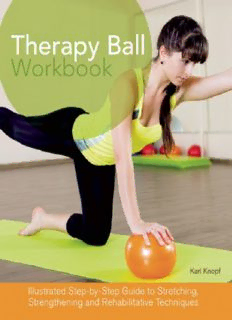
Therapy ball workbook : illustrated step-by-step guide to stretching, strengthening, and rehabilitative techniques PDF
Preview Therapy ball workbook : illustrated step-by-step guide to stretching, strengthening, and rehabilitative techniques
Text Copyright © 2014 Karl Knopf. Design and Concept © 2014 Ulysses Press and its licensors. Photographs copyright © 2014 Rapt Productions. All rights reserved. Any unauthorized duplication in whole or in part or dissemination of this edition by any means (including but not limited to photocopying, electronic devices, digital versions, and the Internet) will be prosecuted to the fullest extent of the law. Published in the United States by Ulysses Press P.O. Box 3440 Berkeley, CA 94703 www.ulyssespress.com ISBN: 978-1-61243-345-5 Library of Congress Control Number 2013922722 10 9 8 7 6 5 4 3 2 1 Acquisitions: Kelly Reed Managing editor: Claire Chun Editor: Lily Chou Proofreader: Elyce Berrigan-Dunlop Indexer: Sayre Van Young Production: Jake Flaherty Cover design: what!design @ whatweb.com Cover photographs: front © Olesya Feketa/shutterstock.com; back © Rapt Productions Interior photographs: © Rapt Productions except on page 6 © marema/shutterstock.com Models: Michael Ciociola, Nadia Velasquez Make-up: Sabrina Foster Distributed by Publishers Group West Please Note This book has been written and published strictly for informational purposes, and in no way should be used as a substitute for actual instruction with qualified professionals. The author and publisher are providing you with information in this work so that you can have the knowledge and can choose, at your own risk, to act on that knowledge. The author and publisher also urge all readers to be aware of their health status and to consult health care professionals before beginning any health program. contents PART 1: OVERVIEW Introduction What’s a Therapy Ball? Why Use Therapy Balls? Therapy Balls and Self-Massage Self-Assessment of Flexibility Before You Begin PART 2: PROGRAMS How to Use This Book Start-Up Routine Core Stability Workout Back Strengthening Workout Total Torso Tune-Up Total-Body Workout Stretch & Relax Muscle Release for Active Folks PART 3: EXERCISES Core Strengthening Leg Extension Leg Circle Heel Slide Pelvic Lift Arm Swing Arm/Leg Combination Curl-Up Supine Stability Orientation Back-On-Ball Crunch Back-On-Ball Twisting Crunch Supine Marching Supine Stability—Arms Supine Stability—Legs Back-On-Ball Leg Lift Alternating Curl-Up I, Y & T Back Extension Double-Arm Lift Double-Leg Lift Prone Arm & Leg Lift Superman Plank Push-Up Ball Switch Push-Up Plank to Pike Plank to Side Salutation Reverse Trunk Curl Arm Pointer Bird Dog Ball Sit Orientation Seated Hip Movement Ball Sit with Foot Lift Ball Sit with Leg Extension Ball Sit with Leg Extension & Arm Raise Pelvic Lift Pelvic Lift with Arm Lift Pelvic Lift with Leg Extension Pelvic Lift with Arm Lift & Leg Extension Conditioning Inner Thigh Toner Inner Thigh Rotation Hamstring Curl Isometric Hamstring Curl Internal & External Shoulder Rotation Wall Squat Stretches & Pressure Release Total-Core Stretch Spine/Neck Lengthener Chest Stretch Ab Stretch Hip Flexor Stretch Inner Thigh Stretch Hamstring/Hip Release Foot Massage Ankle Massage Hamstring Massage Quadriceps Massage Inner Thigh Massage Knee Release Calf Massage IT Band Massage Piriformis Release Glute Massage Upper Back & Shoulder Massage Lower Back Release Lat Release Deltoid Massage Neck Release Chest Massage Hand Massage Forearm Massage Biceps Massage Combo Massage Index Acknowledgments About the Author PART 1 overview introduction Pain is the great equalizer, whether we’re rich or poor, fit or unfit, young or old. Acute pain can cripple you while chronic pain can devastate you. Pain is the main complaint for 40 percent of visits to the family physician. Only 50 percent of those visits have satisfactory outcomes, leaving patients wondering what the cause id and what they can do. Sometimes poor posture and improper body mechanics, along with overtraining specific muscles, lead to increased muscle tension and harmful body alignment. Other times trauma to an area can intensify muscle tension, which can contribute to muscle spasms. If these dysfunctions aren’t addressed properly, they can lead to reduced mobility and chronic physical problems. Frequently there’s no “cure” for the pain, only ways to manage it. The key is to find a method that provides the most benefit for the least amount of risk. The therapy ball is considered one of those options. Each of us has our own unique threshold for pain. Although there’s no universal cure-all that can rid us of these physical annoyances for good, there are many options, such as medication and massage, that can ease our discomfort. There are even methods we can apply ourselves. You’ve probably used a foam roller to loosen tight hamstrings, release your back, and improve your balance. Did you know that the balls you play with, anything from golf balls to basketballs, can provide the same benefits, in addition to keeping your heart healthy? With therapy balls, you can roll your way to better health! Therapy Ball Workbook explains how you can use practically any ball —large or small, soft or hard—as a “therapy ball.” It also presents exercises for physical rehab, core strengthening, posture correction, general conditioning, self-massage and stress relief—all ways to maintain a flexible, strong body and prevent future injury.
Description: